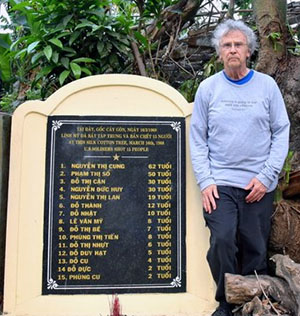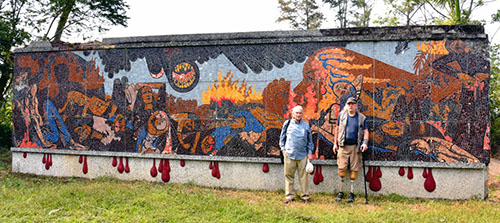 Download PDF of this full issue: v46n2.pdf (24.9 MB) Download PDF of this full issue: v46n2.pdf (24.9 MB) |
Please Help Restore the Mural at My Lai
By Mike Hastie
[Printer-Friendly Version] During a recent trip back to Vietnam with three peace activists, Brian Willson, Becky Luening, and Sandy Kelson (March 28-April 22, 2016), I spent two days at the My Lai Massacre site in Quang Ngai. Aside from being a soldier during the Vietnam War, this was my second visit to the My Lai site, the first time being in April 1994. Being there is not really a visit, it is more like a life experience. Having been very familiar with the breaking story that appeared in Life Magazine (December 5, 1969) and the horrifying pictures that were taken by Army photographer, Ron Haeberle, the experience of being at the memorial site is life revealing. For me personally, I see the My Lai Massacre as a metaphor for the entire war in Vietnam. The United States was responsible for over 20 million bomb craters during the war, what some people have called, My Lai's from the skies.

|
Mike Hastie standing next to a marker with the
names of fifteen Vietnamese civilians who were
murdered at My Lai on March 16,1968.
|
For the most part, while the four of us were walking the grounds, we were the only ones there on April 4-5, 2016. Near the infamous drainage ditch where US soldiers killed 170 civilians, is a large mosaic-tile mural, depicting some of the 504 Vietnamese civilians who were murdered by our government on March 16, 1968, in the last moments of their lives. The mural is very powerful on so many artistic levels. While examining the mural up close, we noticed the artwork had badly deteriorated from years of severe hot and wet weather that causes such damage.
While I was there, I had a private conversation with the co-director of the museum. She has worked at the memorial site for 16 years. I told her I was a veteran, a member of Veterans For Peace, and that millions of Americans who were adamantly against the war, consider the My Lai Massacre site extremely important. I also said, as far as I was concerned, the My Lai Massacre site is sacred ground, and one of the most important memorials in the world. After I mentioned this, she broke down and cried. It was a very powerful moment for both of us. I felt a deep emotional connection to her, and a loving empathy that was so important in healing my soul. Shortly after we talked, she arranged for us to meet one of the lone survivors of the massacre, a Mr. Pham Thanh Cong, who was eleven-years-old when the massacre occurred. Four of his family members were killed by a US hand grenade. Meeting him was an emotional privilege. In his recent book published in 2016, "The Witness From Pinkville," he stated at the end of the book: "If there was one thing I might ask for, that would solely be your sympathy." When we parted, I kissed him on the cheek and said, I was born in America but my heart is Vietnamese.
When I got back to my home in Portland, Oregon, I corresponded with the co-director of the museum via email, and offered to raise the funds needed to restore the mural. She eventually replied that it would cost $4,200 to complete the restoration. Our goal is to raise this money soon so the mural may be completely repaired by the 50th anniversary of the massacre on March 16, 2018. Some of us plan on returning to Vietnam for this historic event. To contribute to this project, please make checks out to VFP Chapter 72, and mail to:
VFP Chapter 72
c/o Bob Projansky
3036 SE Taylor St.
Portland, Oregon 97214

|
|
Sandy Kelson and Brian Willson standing in front of the My Lai mural.
|
Any funds received over the goal, will be given to the My Lai Museum, and upkeep on the grounds.
As a Vietnam veteran, it has been an amazing experience to have faced the truth behind the My Lai Massacre, let alone the entire Vietnam War. Whenever the truth threatens one's core belief system, there is an urgent need to deny its reality. I feel a sense of liberation in knowing that I no longer have to deny my moral injuries. It is a deep healing awareness that is denied many. With sincere appreciation for helping keep a profound historical memory alive.
Mike Hastie was an Army Medic in Vietnam. His father was a career Army officer and WWII combat veteran. He spent most of his early childhood immersed in military culture. When he came back from Vietnam, he picked up a camera to photograph the lie of his childhood. He feels that lying is the most powerful weapon in war and that liberation from denial is everything.
|




